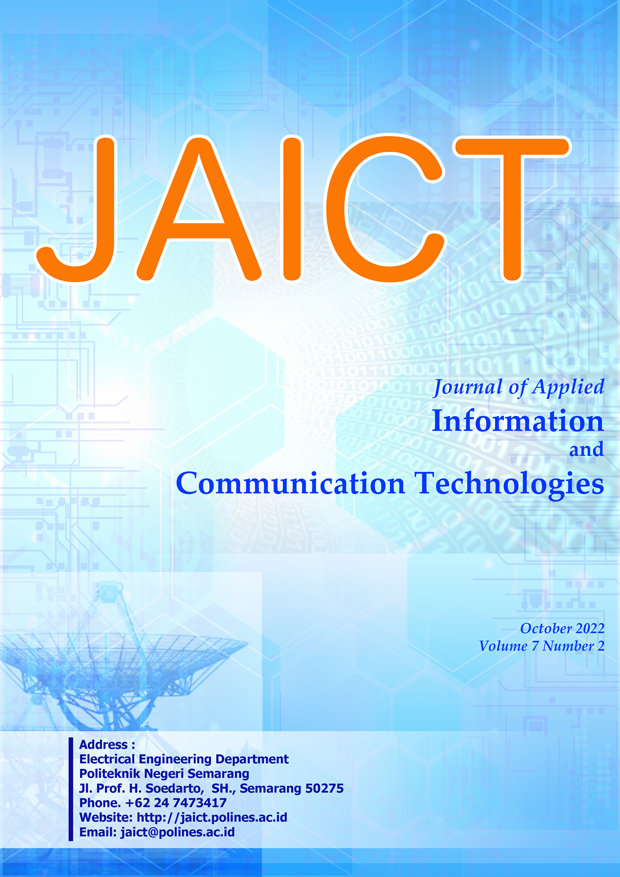VEGETABLE TYPE CLASSIFICATION USING NAIVE BAYES ALGORITHM BASED ON IMAGE PROCESSING
DOI:
https://doi.org/10.32497/jaict.v7i2.3762Keywords:
image processing, vegetables, nave bayes, classificationAbstract
There are so many different varieties of vegetables in Indonesia that the sorting procedure presents difficulties. In an effort to expedite the introduction of smart farming in Indonesia, more agricultural assistance techniques will be created. Utilizing the Naive Bayes algorithm is one way that may be used to advance agriculture in Indonesia. Image processing consists of converting RGB images to grayscale images, segmenting images using the thresholding method, collecting image features based on the HSV average value and object area, and classifying pictures using the Naive Bayes algorithm. This research seeks to use image processing technologies to agricultural products, particularly vegetables. The system is comprised of a single picture captured by a digital camera. There were eight varieties of vegetables employed for the picture data, with a total of eighty consisting of 64 training data and 16 test data. Spinach, green chilies, red chilies, chayote, cucumber, eggplant, tomatoes, and carrots were the vegetables categorized. The categorization findings indicate that 87.5 % of the test values produced using this approach are accurate. This study demonstrates that the Naive Bayes method has a high degree of accuracy for the categorization of vegetables based on image processing. It is anticipated that the findings of this study would promote the implementation of smart farming 4.0 in Indonesia.References
Y. Takaoka and N. Kawakami, “Fruit and vegetable consumption in adolescence and health in early adulthood: a longitudinal analysis of the Statistics Canada”™s National Population Health Survey,” BMC Public Health, vol. 13, no. 1, p. 1206, Dec. 2013, doi: 10.1186/1471-2458-13-1206.
Y. Yohannes, M. R. Pribadi, and L. Chandra, “Klasifikasi Jenis Buah dan Sayuran Menggunakan SVM Dengan Fitur Saliency-HOG dan Color Moments,” ELKHA, vol. 12, no. 2, p. 125, Oct. 2020, doi: 10.26418/elkha.v12i2.42160.
Jannah M, Rochmanto R.A, and Afandi M.A, “Tomato Maturity Detection System Using Color Histogram and Nearest Neighbor,” Journal of Applied Information and Communication Technologies, vol. Vol.7, No.1, 2022, pp. 1”“5, 2022, doi: 10.32497/jaict.v7i1.3074.
A. Saputra, “KLASIFIKASI PENGENALAN BUAH MENGGUNAKAN ALGORITMA NAIVE BAIYES,” Jurnal RESISTOR (Rekayasa Sistem Komputer), vol. 2, no. 2, pp. 83”“88, Oct. 2019, doi: 10.31598/jurnalresistor.v2i2.434.
E. Utama, F. Yapputra, and G. Gasim, “Identifikasi Jenis Mangga Berdasarkan Bentuk Menggunakan Fitur HOG dan Jaringan Syaraf Tiruan,” Jurnal Ilmiah Informatika Global, vol. 9, no. 1, Aug. 2018, doi: 10.36982/jig.v9i1.437.
Y. Pratama, F. Utaminingrum, and W. Kurniawan, “Implementasi Background Subtraction Untuk Klasifikasi Keripik Kentang Berbasis Raspberry Pi Menggunakan Metode Naive Bayes,” 2019. [Online]. Available: http://j-ptiik.ub.ac.id
F. Y. Manik and K. S. Saragih, “Klasifikasi Belimbing Menggunakan Naïve Bayes Berdasarkan Fitur Warna RGB,” IJCCS (Indonesian Journal of Computing and Cybernetics Systems), vol. 11, no. 1, p. 99, Jan. 2017, doi: 10.22146/ijccs.17838.
Downloads
Published
Issue
Section
License
Authors who publish with this journal agree to the following terms:Authors retain copyright and grant the journal right of first publication with the work simultaneously licensed under a Creative Commons Attribution License that allows others to share the work with an acknowledgement of the work's authorship and initial publication in this journal.
Authors are able to enter into separate, additional contractual arrangements for the non-exclusive distribution of the journal's published version of the work (e.g., post it to an institutional repository or publish it in a book), with an acknowledgement of its initial publication in this journal.
Authors are permitted and encouraged to post their work online (e.g., in institutional repositories or on their website) prior to and during the submission process, as it can lead to productive exchanges, as well as earlier and greater citation of published work (See The Effect of Open Access).






